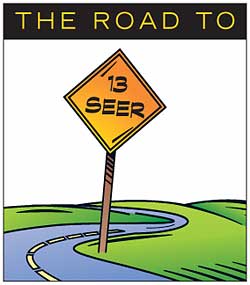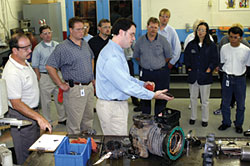
After all, contractors and service firms from coast to coast are selling 13-SEER equipment already. Many contractors do not foresee any disruption in business as the deadline approaches and less-efficient equipment becomes unavailable.
This is not to say that contractors, in general, do not have concerns or issues about the marketplace once the new minimum standard is in place. One issue is the available equipment that will enable them to offer a "good-better-best" range of products to consumers. Some contractors are asking whether or not there will be enough units on the market that truly provide efficiencies of 14 SEER or higher.
After checking the current Air-Conditioning and Refrigeration Institute (ARI) directory, Butch Welsch, president of Welsch Heating and Cooling Co., St. Louis, noted in a guest editorial in The News (Sept. 13), "I find very few matching condensing unit/evaporator coil combinations which are greater than 13 SEER. What are we then going to offer as an upgrade?"
In a follow-up interview with The News, Welsch stated, "Most anything that's above 13 SEER is done with units that use a super-duper oversized coil, or a variable-speed furnace fan or air handler."
Most manufacturers, except for Goodman and a few others, fought the 13-SEER minimum as long as they did, Welsch contended, "because they don't have the product-matching furnace, coil, and condensing units that will provide a ‘good-better-best'" range of choices.
"From a sales standpoint, when we say that 13 is the minimum, there are some of our wealthier customers who don't want the lowest there is," said Welsch.
"We, as a contractor, would like to be able to say we have this 13-SEER unit, which is the standard; we have a 15-SEER unit, which is an upgrade with these features; and then we have a 17- or 18-SEER unit, which is the ‘Cadillac' level. Probably 60 percent of the people will go for the 13 SEER and 20 percent each for the other two," but it is important to have the choices available, Welsch believes.

Views Vary
Welsch's concerns notwithstanding, selling higher-efficiency equipment closer to the 13-SEER level to individual homeowners isn't difficult, one Des Moines, Iowa, contractor rep told The News. He's concerned, however, that rental, apartment, and other multifamily property owners may feel the pinch of higher equipment prices."That [13-SEER minimum] is significantly going to increase the cost on that part of the business," said Jerry Johnson, sales manager for retrofit residential at Wycoff Industries.
The sticker shock of some high-efficiency units may drive some of those rental property owners to "shop us out at that point," said Johnson. The cost difference between a 10-SEER and a 13-SEER package is at least 30 percent, and 40 percent on most jobs, he indicated.
On the other hand, individual homeowners who plan to stay in their homes can be upsold to the 13- or 14-SEER range, Johnson believes. Another factor that may influence efficiency choices is utility rebates. Johnson noted that right now, in his area, efficiency rebates are being paid on 12-SEER units.
"If 13 is going to be the standard, they may not start their rebates (in the future) until 14 or more," said Johnson.
Meanwhile, in Wichita, Kan., business conditions are improving in that area, said Boyd Pope of All Seasons Cooling and Heating, Rose Hill. He said he was already selling "a number of" 13-SEER Puron-using units back before Sept. 11, 2001.
Now that business is picking up after slow times in late 2001 and 2002, "A majority of what we've been putting in has been 12-, 14-, up to 15.5-SEER units," said Pope.
He credited training from Bryant on how to sell higher-end equipment and options, "and it's worked for us."
He foresees some economic pinch for farmers and other rural customers. As the 2006 deadline passes, he may hold back some less-than-13-SEER units to help those who are hurting.
"Otherwise I'll probably sell the 13-SEER units to the majority," he confessed, adding that with higher-efficiency equipment, "you make more money. It takes you about the same time to install. I very seldom even bid 10 SEER."
Pope wondered if pricing of 13-and-higher-SEER units might come down, as that becomes the standard. He said that happened when the 10-SEER minimum went into effect. After a short period of time, "It was almost like the price dropped down to what the 8- and 9-SEER units had been selling for."

More Concerns
Welsch is similarly optimistic about pricing. "We had the same concerns and talk when the minimum SEER went from 8 to 10 back in 1992. It didn't take long before the prices were down, but certainly initially there'll be an incremental cost to go from 10 to 13," he said.While the energy savings of a 13- vs. a 10-SEER unit were hailed in arguments supporting the higher-efficiency level, they don't have much of an impact in areas where cooling loads are moderate.
For example, energy costs aren't significantly impacted by higher-efficiency equipment in Eugene, Ore., said Mark Milligan, owner of Priority One Heating and Air Conditioning. The difference between operating costs of a 10-SEER and a 13-SEER in his area is about $25 a year, he said.
"You'll never get your money back out of it," he stated. Still, "most of what we're doing is probably averaging 13- and 14-SEER already," he added.
"Most of what we do is Energy Star, and [the 2006 deadline] isn't going to change what we do. The ones it's going to hurt are guys who like to do the cheap stuff, and we do upper-end equipment."
But as the minimum SEER standard takes full effect, he conceded, more contractors may move into his best-selling zone.
Much of the "nicer equipment" that Milligan sells includes zoning systems, variable-speed equipment, and a few two-stage compressors on heat pumps "if the application fits." Humidity control is not a big seller in his market, except for customers with special needs.
Meanwhile, Bob Tuck, president of Atlas Heating & Air Conditioning, Oakland, Calif., a firm founded by his grandfather 96 years ago, is also concerned about the 13 SEER requirement.
The 13-SEER minimum, rather than a 12 SEER, "just knocks out a number of lines of equipment that consumers would otherwise have had available. It's rather unfair because a number of major manufacturers don't have a 13 SEER," said Tuck. "They have a 10, 11, 12, and then they go to 14 and then to 16 and 18.
"We deal with low-income, middle-income, and high-income customers, and some people want to have a choice of maybe a lower- SEER unit or a lower-efficiency furnace. We've always been in favor of increased technology, but we're also very much in favor of customers having a wide variety of choice."
Tuck's company is selling a lot of 14-SEER units and even 16- and 18-SEER equipment now to baby boomers who are willing to invest in improving their homes.
"It isn't so much that they're concerned with the environment and overall energy consumption, but they want the best in home comfort," said Tuck. "They are willing to spend for zoning, improved filtration, and other improvements in the basic heating/cooling system.
"They are willing to take out 8- and 10-SEER equipment and 80-percent AFUE furnaces to go to 14 or better SEER and 92.5-percent AFUE furnaces - the best they can get in total indoor comfort."
Next installment: More contractors discuss the absence of an intermediate step in current equipment choices. Plus, find out what the vice president of research and technology, Air Conditioning Contractors of America (ACCA), has to say regarding 13-SEER equipment. And, while "good-better-best" choices to consumers based mostly on SEER ratings might seem to be a logical choice, the advent of 13-and-higher-SEER ratings suggests focusing on more than the numbers, according to Thomas F. Huntington, president of the York International Corp., Unitary Products Group, Norman, Okla.
Norland is a freelance writer from Langley, S.C. He can be reached at JimNorland@aol.com.
Publication date: 09/20/2004

Report Abusive Comment